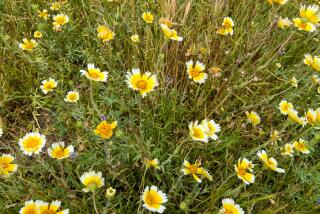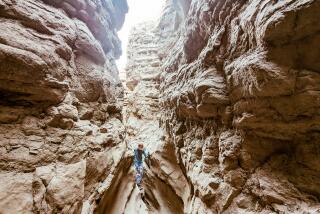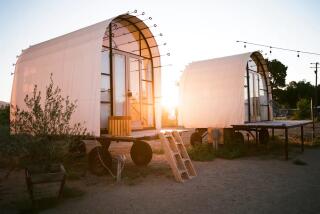Chile’s Atacama Desert: Otherworldly and timeless
- Share via
Reporting from San Pedro de Atacama, Chile — Only four people live in the village of Machuca, 13,000 feet up in the Chilean Andes, and all of them are related to Joel Colque. Colque, who grew up in this stone village that hugs the side of a volcano, is our guide for a daylong trek in the altiplano — the high rocky plateau — above the Atacama Desert, the driest spot on Earth, ringed by 19,000-foot volcanoes where rain evaporates long before it reaches the crusty salt flats far below.
FOR THE RECORD:
Atacama Desert: In the May 22 Travel section, a photo caption with an article on travel in Chile’s Atacama Desert referred to guide Joel Colque as Jose Colque. —
We’re shivering here on a June winter morning, the short alpine plants frozen sharp as needles.
Colque greets his aunts — squat women with long dark braids and colorful ponchos — who weave handicrafts and raise llamas to barbecue for visitors on their way to nearby steaming geysers or high mountain lagoons. They speak Quechua, the Inca language, as well as some Kunza, a nearly extinct language spoken in these northern Andes for centuries.
He tells us that his family has lived in this spot, in the shadow of the volcanoes, since the beginning of time. More recently, Colque’s grandfather climbed the 19,409-foot Licancabur volcano to extract sulfur, and Colque has snowboarded down its slippery peak.
Colque belongs to this ancient world, as well as the world of San Pedro de Atacama, a small town and staging ground for outdoor adventures, full of camping gear stores, hostels, hotels and luxury resorts such as the Alto Atacama desert lodge, where he is the chief guide.
My boyfriend, Peter, and I had arrived in the Atacama after a two-hour flight from Santiago to Calama, an industrial town in a huge copper mining region in the north of Chile. The ride to San Pedro revealed a desolate landscape — why the heck did we come all the way here? — with wide Saharan landscapes interrupted only by mining equipment and workers’ houses.
Then we climbed over an orange mountain range and entered a landscape of textured sand, lunar craters and hoodoo rocks. We were in the Catarpe Valley of the Salt Mountain Range, just a few miles outside the relative oasis of San Pedro (it has a trickle of a river running through), at the Alto Atacama.
The lodge is tucked into terracotta canyons, barely visible from the road. Its interior is chic and spare, designed with local, natural materials and featuring Chilean weavings on the walls.
Terraces look out over a garden of local plants and into the river valley beyond (we later learned that the eco-minded Alto Atacama pumps its water from underground and uses the leftovers to irrigate the plants and trees). The lodge seems to melt into the surroundings and feels cool and comfortable in the midst of the spectacular desert.
We relaxed with a glass of Chilean Malbec while a guide gave us a menu of excursions for the week and asked about our wish list and fitness levels. We’d had visions of climbing volcanoes and even brought heavy-duty boots and down parkas. But it was winter, and the guide told us that we’d need Everest-worthy gear — and training — to get to the top this time of year. We’d also need several days to acclimate to the altitude, which settled it.
As we stared at the huge cones in the distance, we gave up that heroic idea in favor of seeing wonders closer to the lodge.
Although the Atacama is one of the world’s most inhospitable places, it offers a rich variety of outdoor activities and otherworldly landscapes for travelers who make their way to this dry and desolate region. We arranged several excursions but were torn each day between exploring the nature outside our door and staying on our private terrace in a comfy chair with an expansive desert view, with an occasional dip in the hot pools or a visit to the massage therapist. But we needed to do a little work to deserve a massage.
On our first trip, we trekked in the Valley of the Moon, a sandstone world of pink canyons, craters and dunes. We entered an area so dry that it seemed only the rocks were alive and growing.
We learned that the Atacama is so arid that some places haven’t had rainfall in recorded history; the average rainfall is 0.004 inch a year. What humidity exists to slake the thirsty cactuses and scrubby bushes mainly comes from fog that floats in from the nearby Pacific.
After our hike, we stopped at a sunset point where we stood on the edge of steep cliffs and saw the sky and the volcanoes turn thousands of shades of pink.
Each day was a different adventure: Peter and I visited the salt flats, where we watched thousands of pink flamingoes eat their dinner of briny shrimp as the sun set against the rosy Andes. We also mountain-biked sandstone terrain that seemed right out of Moab, Utah, but our favorite excursion was the daylong hike with Colque.
After we met his aunts, we took a shepherd’s path down a river valley. We passed enclosures made of cactus wood to keep in llamas, and clusters of grasses that are used to thatch the roofs of the stone houses. The hike, which was about 10 miles, was the route Colque took each week to go to the closest town with a school.
He told us that when he first walked to the school in Rio Grande, at age 7, he was shocked by how many people were there; he’d never seen a car or electric lights. “My friends were the animals,” he said. “I knew the habits of the snakes and llamas but not of other boys.”
We walked all day without seeing another soul, only a guanaco — the wild animal from which the llama was domesticated. We stopped for lunch at another cluster of buildings that belonged to Colque’s family and were now abandoned. The climate had become too dry to support the terraced farming that the family had subsisted on forever. But Colque said that although many hotels had offered to buy the gorgeous canyon, the family would never sell.
“This is wealth,” he said, gesturing at the vast empty land, the volcanoes and the wide-open sky. “This is all you need.”
More to Read
Sign up for The Wild
We’ll help you find the best places to hike, bike and run, as well as the perfect silent spots for meditation and yoga.
You may occasionally receive promotional content from the Los Angeles Times.






